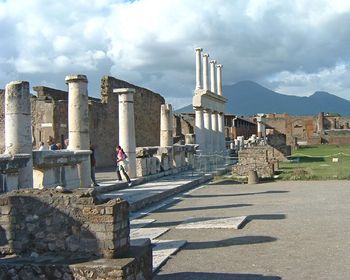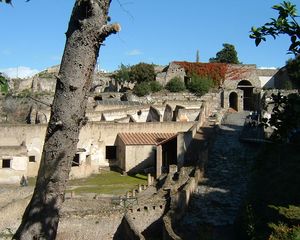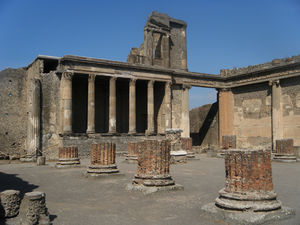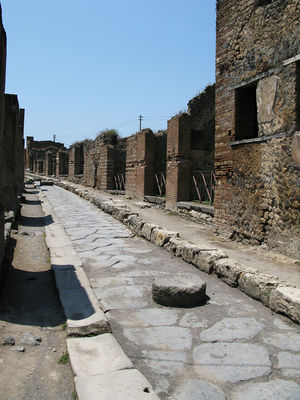Pompeii: Difference between revisions
imported>Richard Nevell (→Rediscovery and Investigation: give Mary Beard's full name on first mention) |
imported>Richard Nevell (→Rediscovery and Investigation: turn final paragraph into a 'preservation' section) |
||
| Line 68: | Line 68: | ||
It is uncertain how many people lived in Pompeii, with estimates varying between 6,400 and 30,000, but the most commonly accepted figure seems to be 20,000. Writing in 2008, Mary Beard noted that about a quarter of Pompeii remains buried. She suggested that the number of bodies recovered within the city (1,100 when she was writing) indicated that many of the inhabitants left Pompeii. An estimate from 1982 put the number of bodies recovered from around Pompeii at 2,000.<ref>Beard, ''Pompeii: The Life of a Roman Town'', p. 10.</ref><ref>Sigurdsson, Cashdollar & Sparkes, "The Eruption of Vesuvius in A. D. 79", p. 51.</ref> | It is uncertain how many people lived in Pompeii, with estimates varying between 6,400 and 30,000, but the most commonly accepted figure seems to be 20,000. Writing in 2008, Mary Beard noted that about a quarter of Pompeii remains buried. She suggested that the number of bodies recovered within the city (1,100 when she was writing) indicated that many of the inhabitants left Pompeii. An estimate from 1982 put the number of bodies recovered from around Pompeii at 2,000.<ref>Beard, ''Pompeii: The Life of a Roman Town'', p. 10.</ref><ref>Sigurdsson, Cashdollar & Sparkes, "The Eruption of Vesuvius in A. D. 79", p. 51.</ref> | ||
==Preservation== | |||
In 1997 Pompeii and nearby Herculaneum became designated a World Heritage Site by UNESCO, recognising the importance of the archaeological sites. The World Heritage Site is named the "Archaeological Areas of Pompeii, Herculaneum and Torre Annunziata". The state of Pompeii's preservation came into sharp focus in 2010 when heavy rainfall triggered the collapse of two well-known buildings within the city: the Gladiators' House and the House of the Moralist. The damage sparked debate over whether Pompeii received enough funding for its preservation, and in 2012 the Italian government began a project of conservation costing an estimated €105 million. The city receives around 2.5 million visitors each year.<ref>"[http://www.unesco.org/new/en/media-services/single-view/news/unesco_and_italy_agree_to_cooperate_on_the_restoration_of_pompeii/ UNESCO and Italy agree to cooperate on the restoration of Pompeii]", UNESCO, 29 November 2011. Accessed 24 October 2012.</ref><ref>"[http://www.bbc.co.uk/news/world-europe-17634115 Pompeii gets cash boost from Italian government]", BBC News, 5 April 2012. Accessed 24 October 2012.</ref> | In 1997 Pompeii and nearby Herculaneum became designated a World Heritage Site by UNESCO, recognising the importance of the archaeological sites. The World Heritage Site is named the "Archaeological Areas of Pompeii, Herculaneum and Torre Annunziata". The state of Pompeii's preservation came into sharp focus in 2010 when heavy rainfall triggered the collapse of two well-known buildings within the city: the Gladiators' House and the House of the Moralist. The damage sparked debate over whether Pompeii received enough funding for its preservation, and in 2012 the Italian government began a project of conservation costing an estimated €105 million. The city receives around 2.5 million visitors each year.<ref>"[http://www.unesco.org/new/en/media-services/single-view/news/unesco_and_italy_agree_to_cooperate_on_the_restoration_of_pompeii/ UNESCO and Italy agree to cooperate on the restoration of Pompeii]", UNESCO, 29 November 2011. Accessed 24 October 2012.</ref><ref>"[http://www.bbc.co.uk/news/world-europe-17634115 Pompeii gets cash boost from Italian government]", BBC News, 5 April 2012. Accessed 24 October 2012.</ref> | ||
==References== | ==References== | ||
{{reflist}} | {{reflist}} | ||
Revision as of 13:00, 27 October 2012
Pompeii was a Roman settlement in Campania, situated where the River Sarno drains into the Bay of Naples. When Pompeii was founded and who by is uncertain,[1] but by the mid-6th century occupied an area of 66 hectares. In the 1st century it became a Roman colony. In A.D. 79 Pompeii and nearby Herculaneum were buried when Mount Vesuvius erupted. The settlement was preserved and has become an important archaeological site. In Roman mythology, Pompeii was founded by Hercules and may have been where the cult dedicated to the demi-god originated.[2]
The site of Pompeii was lost until the 18th century. Marble which had been worked on by masons was found in the area, and led to investigations which resulted in the discovery of Herculaneum. In 1748, Pompeii itself was discovered. In this first phase of rediscovery, investigations were funded by the wealthy but inflicted much damage on the site as artworks were taken away to be displayed in the patrons' homes. Pompeii and Herculaneum gained international renown in 1762 due to the writings of Joachim Winckelmann, but the first rigorous archaeological excavations only began in 1860.[3]
The reason Pompeii is so well known today is not because it was exceptional in its time, but because of its remarkable preservation which offers archaeologists insight into the Roman way of life. In the words of Alison E. Cooley and M. G. L. Cooley: "Pompeii was not a particularly significant Roman town. ... No Pompeian made his mark on Roman literature or politics. No crucial moments in Rome's history hinge on Pompeii. Yet today, because of the accident of its fate, Pompeii is a Unesco world heritage site, attracting up to five hundred times as many visitors each year as actually used to live in the town."[4]
History of Pompeii
Campania, the region in which Pompeii is located, is a fertile area on the west coast of Italy. As well as being the most productive agricultural land in Italy, the region was also well positioned for trade. As a result, several Greek colonies were founded in the area, the most important of which were Cumae (founded in the 8th century B.C.) and Neapolis (now known as Naples and founded in the 7th century B.C.). It is uncertain who founded Pompeii before the Greeks took over, but the historian Strabo wrote that Oscans used to live there. Situated on the mouth of the River Sarnus, the town was a Greek trading post. The Greeks also settled at nearby Stabiae and Herculaneum.[5][6]
Mount Vesuvius is just 8km from Pompeii, and the volcano which destroyed the city also created the landscape on which it was built. The settlement is perched on a volcanic outcrop 39m above sea level, left over from an eruption before records began. Where the flow approached the river it falls into a sharp drop, creating a cliff and a natural defence. Neapolis is 22km away, and the town of Herculaneum is about midway between Neopolis and Pompeii.[7]
In the 7th and 6th centuries B.C. the Etruscans emerged as a leading power in Campania. This saw them try to conquer Greek colonies in Campania and they twice attacked Cumae without success. Archaeologists have recovered Etruscan inscriptions from Pompeii, indicating the town had links to the Etruscans. Historian Michael Grant goes so far as to suggest they may have controlled Pompeii for a while.[8] With the threat from the Etruscans, town walls were built around Pompeii. The walls are still visible today, though with later additions and damage from by a siege in the 1st century B.C. The new walls reflected the growth of Pompeii from a settlement covering about 14 hectares, to 66 hectares.[9] The earliest writings recovered from Pompeii are written in the Etruscan language and were found in the Temple of Apollo. The earliest date from the early 6th century.[10] Etruscan influence waned in the 5th century, and was soon replaced by that of the Samnites. In 421 B.C. they succeeded where the Etruscans had failed by capturing Cumae, and soon after other Greek colonies in Campania, including Pompeii, fell under their control.[8]
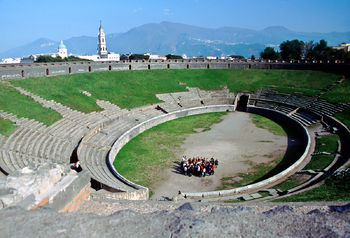
Pompeii's amphitheatre (pictured) is located in the easternmost corner of the city. A in the amphitheatre in A.D. 59 led the banning of gladiatorial games at Pompeii.
Rome in the 4th century B.C. was on the way to establishing itself as the leading power in Italy. The Romans came into conflict with the Samnites, and towards the end of the century Rome succeeded in capturing towns under Samnite control including Pompeii in 310 B.C., and by the turn of the century the region was completely under Roman control. During the Punic Wars – fought between Rome and Carthage in the 3rd and 2nd centuries B.C. – Pompeii stayed loyal to Rome, however rebelled against her authority during the Social War in 91–87 B.C.[11] The Romans, commanded by General Sulla, besieged the city in 89 B.C. An important effect of the war was the Sulla used the town as a colony for several thousand of his veterans. Latin became the dominant language in public inscriptions (replacing Oscan which was the dominant language in the town's surviving writings) and the descendants of the veterans are prominent in the epigraphic record for several generations after the revolt of the early 1st century. Even at the time of the eruption which destroyed Pompeii in A.D. 79 the city bore the marks of Sulla's siege. The town wall is pierced by holes where the Romans aimed their siege engines, missiles have been recovered from the site, and some signs have been interpreted as carrying messages for the town's defenders.[12]
After Pompeii became a Roman colony in 80 B.C. (with an influx of Roman settlers including veterans of Sulla's army) the city had a generally quiet existence with some exceptions. The former soldiers were not particularly welcomed by those already living in Pompeii, and Cicero records that there was some tension between the two groups. A riot in A.D. 59 led to the banning of gladiatorial games in the town for ten years. During a gladiatorial event at the amphitheatre, Pompeians and Nucerians (residents of nearby Nuceria) traded insults and events escalated until weapons were drawn. Some of the Nucerians were killed or injured, and the riot came to the attention of the Emperor Nero who ordered the Senate to investigate.[13][14] The amphitheatre was probably founded around 70 B.C., making it the earliest known stone example of this type of building.[15]
The eruption of Vesuvius: A.D.79
Writing in the 1st century A.D., Strabo stated that while Vesuvius appeared to be a volcano there was no record of any eruptions. There were, however, signs that the volcano was only dormant rather than extinct. Pompeii and Herculaneum were struck by an earthquake on 5 February 62, inflicting severe damage on both settlements.[16] Seneca documented the destruction wrought by the earthquake, which emanated from Vesuvius. it has been estimated that this event may have measured around 5 on the Richter scale. Buildings damaged at Pompeii included the Temple of Isis and the Basilica. Some people living in the region were so disconcerted by the earthquake that they moved elsewhere. This marked the beginning of a period of activity from Vesuvius, with several smaller earthquakes in the following years.[17] The earthquake was depicted in the walls paintings of a house at Pompeii belonging to Lucius Caecilius Jucundus, a local banker.[18] One such painting was located in the household shrine (lararium), suggesting the owner was giving thanks for surviving the event.[19]

When Vesuvius erupted, the inhabitants of Pompeii and Herculaneum were buried. Centuries later plaster was poured into the cavities their bodies left, creating casts of their remains.
On 24 August A.D. 79 Vesuvius began to erupt. It would last until the following day.[20] The eyewitness account of Pliny the Younger is the most important documentary source for the events of that day. At the time Pliny was staying with his uncle, Pliny the Elder, in Misenum on the north coast of the Bay of Naples. The elder Pliny was commander of the fleet at Misenum and on seeing a cloud of smoke rising from Vesuvius set out to investigate. He died on the expedition, and his nephew's account was written decades later in A.D. 106–107 (see Pliny the Younger Letters 6.16 and 6.20).[21] Writing a century later, Cassius Dio documented further details of the eruption.[22]
Using Pliny's account and the stratigraphy of the archaeological record the events of the eruption can be reconstructed. The volcano's first explosions probably began in the morning of 24 August, around 9 or 10am, depositing a thin layer of ash over the surrounding area. At about 1pm a column of pulverised rock was thrown about 20km into the air. It was this cloud that caught the attention of Pliny the Elder at Misenum 30km away. He readied a single ship to investigate, but on receiving news of the events at Vesuvius gave the order as admiral of the fleet at Misenum to prepare more ships to help the people who lived near the volcano. In the meantime, the column of debris rained down on the surrounding area, carried south west by the wind. Distribution of this material was not even, but Pompeii was amongst the most severely affected, and in the space of 18 hours 2.5m of pumice fell on the city. Though pumice is low density (it is porous and often floats on water), the growing weight would have placed considerable stress on the buildings of Pompeii, and it has been estimated that 0.4m of pumice and ash was enough to collapse a roof. Anyone sheltering inside rather than fleeing Pompeii would have risked being crushed to death.[23][24] This stage of activity, in which Vesuvius produced 2.6 million cubic metres of pumice, has been dubbed the Plinian phase.[25]
While Vesuvius erupted, earthquakes shook the region, causing a tsunami at Misenum. On the morning of 25 August, the nature of the eruption changed. As the pumice finished falling, pyroclastic flows hit the surrounding area, burying them in a further 0.5–2m of material. Pliny recorded a dark cloud collapsing down the side of Vesuvius; this was the pyroclastic flow. A second flow followed.[26] Temperatures within pyroclastic flows range from 200oC to 700oC. Anyone caught within it, would have perished.[27]
The Buildings
The walls enclosing Pompeii stretch for 3km and are pierced by eight gates. Moving clockwise from the west they are:the Herculaneum Gate, the Vesuvius Gate, the Capua Gate, the Noa Gate, the Sarno Gate, the Nuceria Gate, the Stabian Gate, and the Sea Gate. The oldest part of Pompeii is the south-west corner, known as The Old Town. The settlement was extended in stages, from the 5th century B.C. and according to Michael Grant this "provides the earliest known systemic urban layout in Italy".[28] The town's streets are narrow, usually between 2.4m and 4.5m wide. Refuse and water collected in the streets, and stepping stones helped citizens cross them; vehicles would have been unimpeded as they usually had high axles. Intersections were often decorated with fountains.[29][30]
Though nothing stands of the first buildings, the area's antiquity can be discerned through its irregular street pattern, while the rest of Pompeii is more ordered. The earliest standing structures date from the late 4th century B.C., and the only trace of the early town is to be found in the town's layout. Excavations have shown that inhabited areas grew beyond the city walls near the gates. Building work stagnated in the mid-1st century A.D. Two public buildings – a temple dedicated to the Emperor Vespasian and a building dedicated to the gods protecting the city – were built but these were the exception. By A.D. 79 many buildings were still not fully repaired after the serious earthquake nearly two decades earlier. Of the public buildings only the Temple of Isis and the amphitheatre were fully repaired.[28]
Southern Italy saw the emergence of several distinct public buildings which would later become common place in Roman architecture: amphitheatres, basilicas, baths, and Roman theatres. Pompeii offers insight into the latest building fashion: the oldest surviving basilica it to be found at Pompeii (located next to the Forum), while the amphitheatre is the oldest known stone-built structure of its type. The amphitheatre at Pompeii was located in the eastern corner of the city walls. It was common for Roman amphitheatres to be located on the peripheries of settlements. The area where events took place is oval and measures 67m by 35m. Including its seating (which could hold up to 20,000 people; about the population of Pompeii itself) the oval amphitheatre measured 140m by 105m.[31][15][32]
Politics and People
The Roman rule imposed by Sulla in 80 B.C. led to the implementation of a Roman form of governance. Surviving inscriptions allow historians to piece together Pompeii's political history from that time until its destruction in A.D. 79. The sources range from dedications on monuments to campaign posters (around 3,000 elections posters survive, etched on the walls of Pompeii), and they present a more detailed political history for any Roman settlement other than Rome. A council, known as the ordo decurionum, was established and had between 80 and 100 councillors (decurions).[33]
Only certain groups were allowed to become decurions, and an important qualification was owning a certain amount of property. Meeting of the ordo decuriunum were presided over by two duovir, senior magistrates. Two junior magistrates known as aediles helped the daily running of the city, dealing with issues such as clearing the streets. Magistracies were elected positions and fiercely contested in Pompeii, with the city' free citizens voting every year. Elections were held in March each year and holders entered office on 1 July. In the 1st century B.C., the politician Cicero wrote that it was harder to become elected to the council in Pompeii than the Senate in Rome.[33][34]
When Sulla established Roman rule at Pompeii in 80 B.C. the previous inhabitants were banned from holding public office, though inscriptions demonstrate their decedents permeated positions of power.[35] One effect of the influx of colonists in the 1st century B.C. was the introduction of Roman funerary rights: tombs and monuments to the deceased were erected lining the roads to and from Pompeii and were common at other Roman settlements.[36] Pompeii, along with the nearby towns of Herculaneum and Stabiae were destroyed. After the eruption ended people were sent to the area to assess what could be done, but only the roofs of the tallest buildings could be seen. Some statues were recovered, and presumably some portable valuables, but the area was abandoned and it eventually became farmland. Herculaneum fared worse, and survivors did not attempt to recover their belongings. Survivors settled elsewhere, and the location of Pompeii passed out of living memory and remained hidden for centuries.[37][38]
Rediscovery and Investigation
As the centuries passed, soil accumulated over the buried city, so that by the time excavations began archaeologists had to dig through 2m of top soil (meaning the Roman ground level was 6m underground). Though an inscription mentioning Pompeii was discovered when the River Sarno was diverted in 1594, it was not until the 18th century that the city was rediscovered. Herculaneum was discovered by accident in 1709 and organised excavations began in 1738. The growing interest surrounding Herculaneum provoked Roque de Alcubierre to investigate the site where the inscription was found in 1594, and in 1748 he began excavations. The city was not identified until 1763 when an inscription with the settlement's name was recovered. Classicist Joachim Winckelmann visited the excavations of Herculaneum in 1762 and his letters elevated it and Pompeii to international renown. The Herculaneum Academy was founded in 1775 to support the investigation of the site, and many of the discoveries from Pompeii and Herculaneum. Many of the discoveries from the settlements of Vesuvius are now housed in the National Archaeological Museum at Naples.[39]
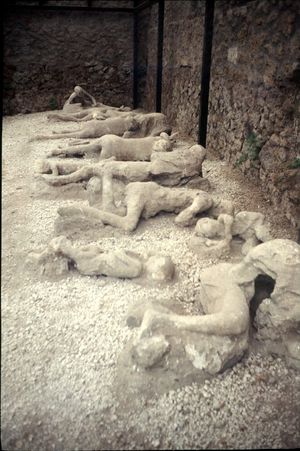
The technique of filling cavities with plaster to recreate the bodies of those who died at Pompeii was invented in 1864.
The inhabitants who had died during the eruption left behind cavities in the volcanic ash where their bodies decayed; in 1864 Giuseppe Fiorelli developed the method of filling these cavities with plaster. When broken apart, the solidified ash would reveal the figure who had died in Pompeii. In some cases the casts were so detailed that clothes could be made out. Under Fiorelli, scientific investigation of Pompeii flourished.[40]
Rome's Forum was not extensively excavated until the 1870s, so Pompeii in the early 19th century offered the first insight into significant remains of a Roman forum. The ruins of Pompeii have undergone significant alterations after their excavation. For instance in the early 20th century it was common to replace Roman walls with damp proof walling.[41] Excavations at Pompeii were halted by the Second World War. In 1943 fighting moved to Naples and the Americans bombed any buildings identified as barracks near Naples. It was a assumed that buildings with metal roofs were Nazi barracks, however some areas of Pompeii were protected by metal sheeting, thus inadvertently making it a target and causing considerable damage. In all, 162 bombs were dropped on Pompeii. The act was described historian Ronald Schaffer as having "no apparent military reason", and aside from the eruption of Pompeii is considered by classicist Mary Beard as the "biggest damage Pompeii ever suffered".[42][43][44][45]
The majority of archaeological investigations in Pompeii have been focussed on its state at the time of its destruction. As a result relatively little is known about the site's earlier history. It is thought that the "Old Town" (in the south-west corner of the archaeological site) covered about 14 hectares and was centred around the Temple of Apollo and the Triangular Forum. The settlement expanded to the north and east to cover 66 hectares,[46] which was about average for a Roman town in the early Empire.[47]
It is uncertain how many people lived in Pompeii, with estimates varying between 6,400 and 30,000, but the most commonly accepted figure seems to be 20,000. Writing in 2008, Mary Beard noted that about a quarter of Pompeii remains buried. She suggested that the number of bodies recovered within the city (1,100 when she was writing) indicated that many of the inhabitants left Pompeii. An estimate from 1982 put the number of bodies recovered from around Pompeii at 2,000.[48][49]
Preservation
In 1997 Pompeii and nearby Herculaneum became designated a World Heritage Site by UNESCO, recognising the importance of the archaeological sites. The World Heritage Site is named the "Archaeological Areas of Pompeii, Herculaneum and Torre Annunziata". The state of Pompeii's preservation came into sharp focus in 2010 when heavy rainfall triggered the collapse of two well-known buildings within the city: the Gladiators' House and the House of the Moralist. The damage sparked debate over whether Pompeii received enough funding for its preservation, and in 2012 the Italian government began a project of conservation costing an estimated €105 million. The city receives around 2.5 million visitors each year.[50][51]
References
- ↑ Beard, Mary (2008) Pompeii: The Life of a Roman Town, p. 34. London: Profile Books. ISBN 9781846684715.
- ↑ Cooley, Alison & Cooley, M. G. L (2004). Pompeii: a sourcebook, pp. 6–8, 17. London: Routledge. ISBN 9780415262118.
- ↑ Renfrew, Colin & Bahn, Paul (2004). Archaeology: Theories, Methods and Practice, 4th edition. Thames & Hudson. pp. 24–25. ISBN 0-500-28441-5.
- ↑ Cooley & Cooley, Pompeii: a sourcebook, p. 1.
- ↑ Grant, Michael (1976). Cities of Vesuvius: Pompeii & Herculaneum. pp. 15–17. London: Penguin Books.
- ↑ Cooley & Cooley, Pompeii: a sourcebook, p. 7.
- ↑ Grant, Cities of Vesuvius: Pompeii & Herculaneum. pp. 17–21.
- ↑ 8.0 8.1 Grant, Michael (1976). Cities of Vesuvius: Pompeii & Herculaneum. p. 20. London: Penguin Books.
- ↑ Ward-Perkins, John & Claridge, Amanda (1976). Pompeii AD79. Bristol: Imperial Tobacco Limited. p. 33. ISBN 0905692-00-4.
- ↑ Cooley & Cooley, Pompeii: a sourcebook, p. 5.
- ↑ Grant, Cities of Vesuvius: Pompeii & Herculaneum. p. 22.
- ↑ Cooley & Cooley, Pompeii: a sourcebook, pp. 17–18.
- ↑ Grant, Cities of Vesuvius: Pompeii & Herculaneum. p. 23.
- ↑ Cooley & Cooley, Pompeii: a sourcebook, pp. 60–61.
- ↑ 15.0 15.1 Welch, Katherine E. (2007). The Roman Amphitheatre: From Its Origins to the Colosseum. Cambridge: Cambridge University Press. pp. 72–74. ISBN 978-0-521-809443.
- ↑ Grant, Cities of Vesuvius: Pompeii & Herculaneum. pp. 26–28.
- ↑ de Carolis, Ernesto & Patricelli, Giovanni (2003). Vesuvius, A.D. 79: The Destruction of Pompeii and Herculaneum. Roberto Marcucci. p. 74. ISBN 88-8265-199-1.
- ↑ Grant, Cities of Vesuvius: Pompeii & Herculaneum. p. 28.
- ↑ Cooley & Cooley, Pompeii: a sourcebook, p. 29.
- ↑ de Carolis & Patricelli, Vesuvius, A.D. 79: The Destruction of Pompeii and Herculaneum, pp. 76–78.
- ↑ Cooley & Cooley, Pompeii: a sourcebook, p. 32.
- ↑ de Carolis & Patricelli, Vesuvius, A.D. 79: The Destruction of Pompeii and Herculaneum, pp. 77–78.
- ↑ de Carolis & Patricelli, Vesuvius, A.D. 79: The Destruction of Pompeii and Herculaneum, pp. 78, 83–78.
- ↑ Martini, Kirk (1997), "Phenomena at Pompeii", University of Virginia School of Architecture. Accessed 15 October 2012.
- ↑ Sigurdsson, Haraldur; Cashdollar, Stanford; and Sparkes, Stephen R. J. (1982). "The Eruption of Vesuvius in A. D. 79: Reconstruction from Historical and Volcanological Evidence", American Journal of Archaeology, vol. 86, no. 1, pp. 39–51.
- ↑ Sigurdsson, Cashdollar & Sparkes, "The Eruption of Vesuvius in A. D. 79", pp. 48–50.
- ↑ "Pyroclastic Flows and Their Effects", United States Geological Survey. Accessed 15 October 2012.
- ↑ 28.0 28.1 Ward-Perkins & Claridge, Pompeii AD79, pp. 42–45.
- ↑ Grant, Cities of Vesuvius: Pompeii & Herculaneum. p. 45.
- ↑ Grant, Cities of Vesuvius: Pompeii & Herculaneum. pp. 46–50.
- ↑ Ward-Perkins & Claridge, Pompeii AD79, p. 46.
- ↑ Beard, Pompeii: The Life of a Roman Town, p. 260.
- ↑ 33.0 33.1 Ward-Perkins & Claridge, Pompeii AD79, pp. 39–40.
- ↑ Grant, Cities of Vesuvius: Pompeii & Herculaneum. pp. 205–207.
- ↑ Ward-Perkins & Claridge, Pompeii AD79, pp. 40–41.
- ↑ Cooley & Cooley, Pompeii: a sourcebook, p. 19.
- ↑ Grant, Cities of Vesuvius: Pompeii & Herculaneum. pp. 38, 215.
- ↑ Ward-Perkins & Claridge, Pompeii AD79, p. 37.
- ↑ Grant, Cities of Vesuvius: Pompeii & Herculaneum. pp. 31, 215–217.
- ↑ Grant, Cities of Vesuvius: Pompeii & Herculaneum. pp. 34, 218.
- ↑ Beard, Mary (2009). "Pompeii: The Art of Reconstruction", AA Files, no. 58, pp. 3–5
- ↑ Harris, Judith (2007). Pompeii Awakened: A Story of Rediscovery. London: I B Tauris & Co Ltd. p. 228. ISBN 978-1-84511-241-7.
- ↑ Schaffer, Ronald (1985). Wings of Judgement: American Bombing in World War II. Oxford: Oxford University Press. p. 50. ISBN 0-19-503629-8.
- ↑ Beard, "Pompeii: The Art of Reconstruction", p. 4.
- ↑ Grant, Cities of Vesuvius: Pompeii & Herculaneum. p. 218.
- ↑ Cooley & Cooley, Pompeii: a sourcebook, pp. 5–6.
- ↑ Grant, Cities of Vesuvius: Pompeii & Herculaneum. p. 45.
- ↑ Beard, Pompeii: The Life of a Roman Town, p. 10.
- ↑ Sigurdsson, Cashdollar & Sparkes, "The Eruption of Vesuvius in A. D. 79", p. 51.
- ↑ "UNESCO and Italy agree to cooperate on the restoration of Pompeii", UNESCO, 29 November 2011. Accessed 24 October 2012.
- ↑ "Pompeii gets cash boost from Italian government", BBC News, 5 April 2012. Accessed 24 October 2012.
- Pages using ISBN magic links
- Editable Main Articles with Citable Versions
- CZ Live
- Archaeology Workgroup
- History Workgroup
- Classics Workgroup
- Articles written in British English
- Advanced Articles written in British English
- All Content
- Archaeology Content
- History Content
- Classics Content
- Archaeology tag
- History tag
